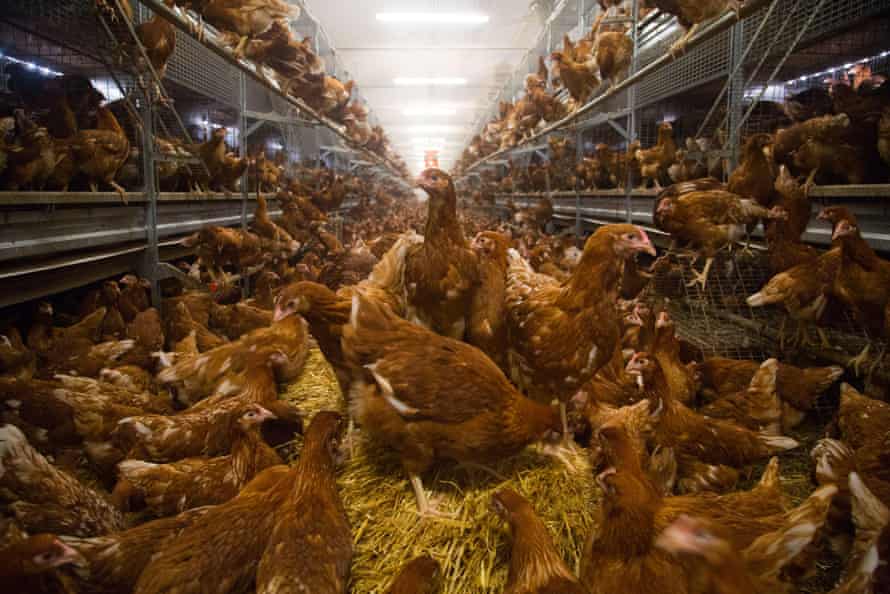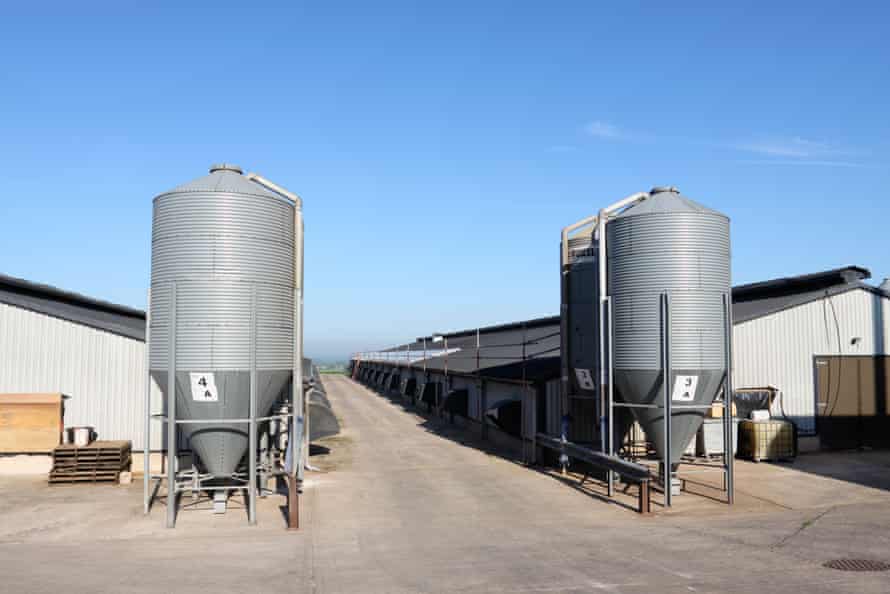Growing up on the family farm in rural Herefordshire, Richard Corbett’s fondest memories are of tinkering in his father’s workshop. “I always assumed I’d be a farmer,” says the 55-year-old. “But if I’m honest, as a teenager I preferred messing about with machinery.”
Today, Corbett’s engineering passion is channelled into maintaining his beloved road bike, and the family farm is a multimillion-pound concern. The vast majority of that annual turnover comes from rearing chickens.
With eight sites across the three neighbouring counties of Herefordshire, Shropshire and Powys, Corbett has been at the centre of Britain’s poultry boom – and slap bang in the eye of its storm.
The UK produced 1.7m tonnes of chicken meat in 2020, up 28% from a decade before. Meanwhile, the retail price of chicken is down almost a quarter since 2014 – meaning the average supermarket bird costs less than a pint of beer.
Of the 1.1 billion broiler chickens slaughtered each year in Britain, about 25% are raised in Herefordshire and Shropshire, according to a PhD study by Cardiff University researcher Alison Caffyn.
Alarmed by the steady stream of poultry shed planning controversies in her home county of Shropshire, Caffyn has spent four years unravelling the industry’s explosive growth in this corner of Britain.
“I think people are nervous of criticising farming,” she says, explaining the scarcity of insight into large-scale poultry units.
“A phrase came up in my research a couple of times: ‘Well, we all pussyfoot around the farmers don’t we?’ I think that is one of the cultural factors for why there has been little resistance to the development of intensive farming.”
In Powys, the density of poultry farms has reached a level unmatched in Europe, according to the Campaign for the Protection of Rural Wales.
Next door in Herefordshire and Shropshire, poultry units have almost doubled in size and more than tripled in number to 1,150 – housing 38 million birds – in the space of two decades, building on the counties’ rich chicken-farming tradition.

Corbett’s late grandfather, former Conservative MP Uvedale Corbett, was a founding member of Hereford’s Sun Valley farmer cooperative, established in 1960 to pack chickens for Marks & Spencer.
In Shropshire, John Percy Wood was dealing poultry as far back as 1830. His sons grew the business under the Chukie Chicken brand. By the 1970s it was one of the biggest in the UK, processing 3 million birds at a time.
But Sun Valley’s takeover by US conglomerate Cargill in 1980 cemented the region’s future as the UK poultry capital.
“People talked about how Cargill went from being a group of local poultry farmers working together, to ‘something other’,” says Caffyn. “It shifted gear, and became a different sort of company.”
Cargill invested GBP35m in the Hereford site, announcing in 2008 that it was actively seeking poultry producers.
A decade later, it joined forces with Faccenda to create Avara Foods. Following a further GBP6.5m spend on Hereford in 2019, Avara became the third-largest poultry processor in the UK, supplying Asda, Nando’s, Lidl and Tesco, and processing 4.5 million birds a week across three sites.
Avara spokesman Thomas O’Neil says: “There are obvious welfare benefits of using farms that are within a reasonable journey time to the processing plant, but it’s also worth noting that while we have key operations in Hereford, not all the farms in those areas are in our supply chains.”
Cargill and, latterly, Avara’s growth has helped catalyse farm diversification and a shift from more traditional mixed farming to poultry.
While Corbett also produces cider apples for Bulmers and blackcurrants for Ribena, he signals a declining profitability in farming other livestock as a reason for poultry’s appeal.
“All farms used to be mixed farms, but these days you have no option but to specialise as the margins are so small,” he says. “Years ago, we used to have pigs but the reality is they’re just not profitable. Same with sheep.”
Contracted exclusively by Avara, he rears laying hens, which in turn hatch broiler chicks then raised at neighbouring farms for the same firm.
“Under contract, farmers know pretty much exactly what they’re getting paid and when,” he says. “It takes away the uncertainty.”
Another farmer, desperate to diversify and seeking permission to build a broiler unit in Powys, says there is “no money” in sheep and cattle. A double whammy of Brexit uncertainty surrounding farm subsidies and trade deals has added to their woes.
“No one is eating red meat,” they say, nervous of being named. Their grown up children are getting by on “pocket money”, they add.
The poultry boom across the region has fuelled controversy, with campaigners dismayed at the apparent ease with which new sheds are approved.
Cllr Andy Boddington has been on the Southern Shropshire planning committee for seven years.
He confesses to feeling hamstrung by the lack of policy guidance on intensive poultry units in either the county’s local plan, or the government’s national planning policy framework.
“It’s really frustrating that we don’t have the tools in our planning toolbox to get to grips with applications,” he says.
“I think there’s a culture in the planning department of saying, ‘Oh, it’s another chicken shed – let’s approve it’. We no longer have a planning machine, we have a permitting regime. It’s not about strategic planning at all.”
Yet specialist rural planning consultant Ian Pick says it is harder than ever to secure permission for a new project – with nine out of 10 failing at the pre-planning phase.
“The sheer cost of the process means we don’t even apply unless we’re 99.9% certain they’ll get through,” he says, pointing to the average GBP50-GBP60k outlay for a planning application and reports for a four broiler-shed site.

In north Herefordshire, a planning moratorium has been in place since October 2019 after Natural England found phosphate levels in the River Lugg to be above acceptable limits.
In Knighton, Powys, campaigners opposing a 111,000-bird poultry unit had its planning permission revoked under judicial review in January. However, the farm – Llanshay – has since resubmitted its plans with new manure management proposals and the inclusion of ammonia scrubbers.
“They’re planning to take the manure to an anaerobic digester in Shropshire,” says Camilla Saunders of Sustainable Food Knighton. “Basically they want to shovel their crap over the border while industrialising the countryside to make food.”
Back in Shobdon, Herefordshire, Corbett admits the area is now “pretty saturated”.
Avara is ploughing cash into its site in Brackley, Northamptonshire, with GBP11m announced for new packing hall equipment and staff facilities. The region is emerging as a new front for anti-poultry campaigners.
But ultimately, it will be the shopper in the supermarket – “the most important person in our supply chain”, according to Corbett – who sets the sector’s future course.
“If people don’t buy it, we don’t produce it,” he says, before pointing out the irony that higher welfare poultry farming, which means lower stocking densities and more floor space, can only mean more or bigger sheds – and potentially pricing lower income families out of a source of protein.
Jonty Hay, director of Hay Farms – one of the UK’s largest poultry producers – perhaps best exemplified this consumer power in his address to the Pig and Poultry Fair’s online forum last month.
“Will we be eating meat in 20 years?” he pondered. “I don’t know. It’ll be an interesting one. But what we do have to do is adapt and move with the consumer.”
Sign up for the Animals farmed monthly update to get a roundup of the best farming and food stories across the world and keep up with our investigations. You can send us your stories and thoughts at animalsfarmed@theguardian.com